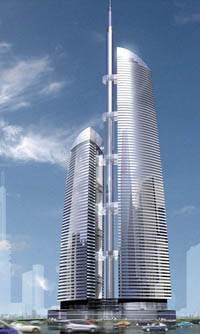
Moscow is fulfilling its dream - building skyscrapers for boutiques, apartments, and offices
 |
"We experienced a significant crisis in this regard. There was a long period during which all construction was restricted in various ways. You may be tired of heights, but we are drawn to them," said Alexander Kuzmin, the chief architect of Moscow, to ČTK. According to him, high-rise buildings have a future in Russia. This has supposedly been confirmed by surveys among investors who inquired potential tenants before the beginning of construction about their interest in working or living in skyscrapers.
On the left bank of the Moscow River, the cornerstone for the tallest building in Europe was laid at the beginning of this year. The Federation Tower, which is supposed to resemble a narrow ship with sails, is expected to reach a height of 340 meters, with a spire possibly extending to 440 meters.
"Initially, we wanted to build the tallest building in the world, but we then settled for European primacy. After all, construction is not ending," Kuzmin said with a smile. Currently, seven floors of the future skyscraper rise from the massive construction site. In two years, a building with 87 floors is expected to be completed, and the side tower is set to have 57 floors.
The entire modern complex Moscow-City will cover 2.5 million square meters, where offices, apartments, and luxury hotels will be constructed. The underground will be dedicated to shops, while the upper floors are intended to house restaurants, gyms, swimming pools, and observation decks. One of the skyscrapers is also expected to serve the Moscow City Hall; the mayor is supposed to relocate here as well.
"We anticipate that the center will accommodate around 150,000 people. Of these, 80,000 will be for work, and 70,000 will come for entertainment or shopping," Kuzmin stated. According to the chief architect of Moscow, the city is already experiencing its second wave of construction fever. The first wave began after the collapse of the Soviet Union and cooled down with the onset of the financial crisis in 1998.
The project was approved back in 1992, when Moscow's mayor Yuri Luzhkov signed it. The work on the commercial center has not stopped for the past ten years. Thousands of workers are constructing buildings of glass, concrete, and steel. So far, only a few lower buildings have been completed, while the rest of the area resembles an anthill. Deep excavations reveal the foundations and underground floors of the future skyscrapers. All buildings are being constructed by private investors, while the Moscow City Hall provided the cleared land, established engineering networks, and built the necessary infrastructure.
This week, Mayor Luzhkov also inaugurated a new line of the so-called "mini-metro" directly in the future commercial center. This will connect the Moscow-City center with the existing transportation network of the Russian capital.
Whether this ambitious project will be as successful as architect Kuzmin and private investors believe remains uncertain. High office rental prices in the Russian capital have not been falling despite the large supply and extensive advertising campaigns by investors. And the empty windows of many already constructed modern skyscrapers suggest that they still do not have any tenants.
The English translation is powered by AI tool. Switch to Czech to view the original text source.
0 comments
add comment










